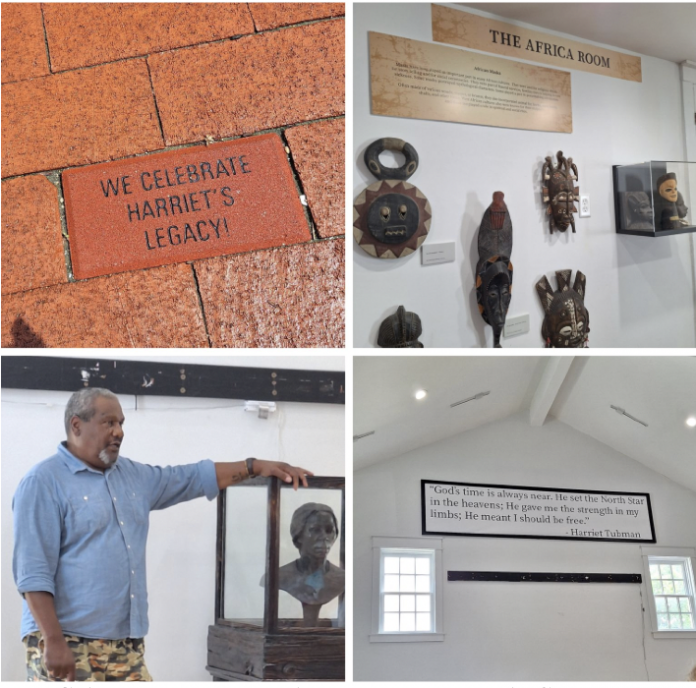About five years ago, I was in Cape May, NJ, and saw signs promoting the soon-to-be Harriet Tubman Museum, so it was without a doubt I planned to go on the tour during my visit recently to the historical town. The Harriet Tubman Museum highlights the pivotal role Cape May played in the fight for freedom. But what made the experience complete was the combination of the Underground Railroad Trolley Tour and the Harriet Tubman Museum Tour.
Cape May was part of the Underground Railroad, and this trolley tour, which is part of the National Park Service’s Network to Freedom and also one of just 13 sites nationwide on the Park Service’s Travels with Tubman app, tells of those dangerous days. Enslaved persons fled their captors in Maryland, Delaware, and Virginia and braved strong currents and stormy seas, guided by the beacon at the Cape May Lighthouse. The Trolley tour is co-sponsored by the Center for Community Arts (CCA) and Cape May MAC (Museums Arts Culture).
“Taking Cape May’s Underground Railroad Trolley Tour in combination with a visit to the Harriet Tubman Museum gives visitors an even deeper understanding of the stories of danger and bravery for freedom seekers during this time in our shared history,” said Susan Krysiak, Director of Media Relations for Cape May MAC.
The Harriet Tubman Museum officially opened in 2021 to national accolades. Harriet Tubman lived in Cape May in the early 1850s, working to help fund her missions to guide enslaved people to freedom. After her initial journeys conducting freedom seekers to Canada, her friend, and abolitionist leader Franklin Sanborn wrote, “She returned to the states, and as usual earned money by working in hotels and families as a cook. From Cape May, in the fall of 1852, she went back (once more) to Maryland and brought back nine more fugitives.”
The Harriet Tubman Museum is a tribute to the rich history of abolitionist activism on this block, explained Cindy Mullock, Founding Executive Director of the museum.
“We came together as a group five years ago for a historical preservation project to restore the Hallow House home as the Harriet Tubman Museum,” she explained. “This was one of the buildings in Cape May (that she lived in), and Harriet Tubman and the abolitionists were organizing right here on Lafayette Street with the help of Steven Smith, the founder of the Anti-Slavery Society in Pennsylvania.”
The Harriet Tubman Museum building is on a block that anti-slavery activists called home in Cape May. Lafayette Street and Franklin Street became the center of abolitionist activity, centered around three important buildings developed in 1846.
The Stephen Smith House stands at 645 Lafayette Street, across from the site of the Harriet Tubman Museum, where Stephen Smith built his summer home in 1846. The Banneker House was next to the Stephen Smith House. The Banneker House became a first-class hotel and one of the only summer resorts for free Black people in the country, and was developed by James Harding, a friend of Stephen Smith.
The white Baptist Church was located directly across the street from the Stephen Smith House, and Joseph Leach frequently preached there. Leach was a political leader and editor of the Ocean Wave newspaper, where he often wrote accounts of enslaved people who fled to Cape May. The congregation of the church issued a strong condemnation of slavery.
The tour, which took place in three big rooms displaying a variety of artifacts, literature, and an informative, interactive presentation by Tour Guide Ross, was very engaging. He shared information about Harriet Tubman’s life and time in Cape May as well as the Black history in the town.
Parents brought their children to learn about the historical culture of Cape May. It was obvious that Ross had a strong passion for his storytelling. “I was raised here in this town, and I didn’t know who Harriet Tubman was until I became an adult. So, learning this information was hidden and kept from us. My resolve was to recover the history, bring it to the forefront, and let the world know who our heroes are.”
“We had a very strong Black community years ago,” said Mullock. ‘A large percentage of our residents were African Americans, and now, with the combination tour, people came from every state and country to stop through our town to learn of this history. There has been an incredible reception from the local community as well.” Mullock added, “Everyone adopted the program and pitched in and volunteered to restore the home space for the history of our neighborhood, which became a local, national sensation and a great tribute to an amazing woman’s legacy.”
This combination tour is co-sponsored by the Harriet Tubman Museum of New Jersey, Cape May MAC, and the Center for Community Arts (CCA).
Trip to Cape May: From Ocean to Harriet Tubman Museum (Part II)
Reading Time: 3 minutes


